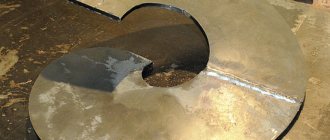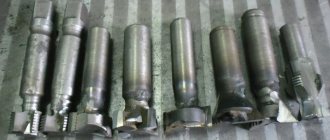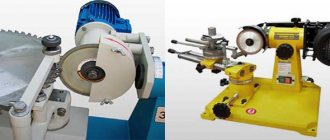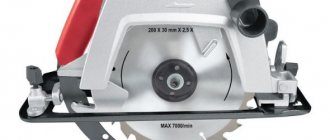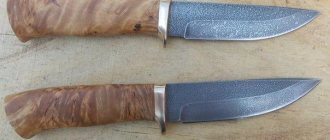Working tools and materials
The raw material for creating a handicraft knife can be any used or new cutting component made of hardened steel. As a semi-finished product, it is advisable to use saw wheels for metal, concrete, saw wheels for pendulum end saws and hand saws. A decent material would be a used gasoline saw. From its chain it is possible to forge and make a blade, which in its properties and appearance will be no worse than the legendary Damascus blades.
To create a knife from a circular disk with your own hands, you will need the following equipment and materials:
- angle grinder;
- emery machine;
- electric drill;
- ruler;
- hammer;
- sandpaper;
- whetstones for sharpening;
- files;
- center punch;
- epoxy;
- copper wire;
- felt-tip pen;
- container with water.
To create a handle, it is preferable to use:
- non-ferrous alloys (silver, brass, bronze, copper);
- wood (birch, alder, oak);
- plexiglass (polycarbonate, plexiglass).
The material for the handle must be solid, without cracking, rottenness or other defects.
How to determine wear?
Checking the saw blade for wear is an important issue that should be given special attention. Deep damage makes it impossible to sharpen the wheel.
There are three main signs by which you can understand that the saw needs to be sharpened or replaced:
- The protective casing becomes very hot and produces smoke. The circular saw has a special casing that indicates that the saw has become dull due to heat. In particularly difficult situations, smoke may appear from it.
- Sometimes the saw design involves a mechanical feed (if you need to manually adjust the pressure force). In such a situation, wear can be noticed if the pressure has to be increased.
- If, when sawing wood, carbon deposits and a strong unpleasant odor are formed on the workpiece.
All the situations described above tell the user that it is time to sharpen the device.
Other part processing methods
If for some reason you can’t make a knife out of it, because you don’t have the necessary material, replace it. A car spring, the metal of which is softer than that of a saw, is well suited for making a blade. To process such a workpiece, you do not have to use a sharpener, but you will need a metal saw to cut out the shape of the blade. Since metal is easier to process, the edges of the workpiece can be adjusted with a file. It will take longer to make a knife this way, because each stage of processing involves manual work.
Making a knife from a saw is a labor-intensive process, but the result is worth it. By making a knife from a saw with your own hands, you will receive a high-quality and unique blade.
My friend and I decided to make knives from the same steel and the same shape, but I make them by hand and he uses power tools.
I was wondering how long it would take me to make a knife for concrete or metal using just files and a drill and my hands. I was very pleased with the result.
Design Features
Structurally, a homemade sawing table looks quite simple. The machine consists of a supporting frame for mounting the motor, a transmission unit and a work table with a slot for the cutting disk. The design is equipped with stops for guiding the workpiece and a protective screen that prevents chips from entering and also increases work safety.
Mandatory requirements for a sawing table:
- rigid, stable design;
- smooth surface of the tabletop;
- secure disk mounting;
- fencing protecting the operator of the machine (table);
- easy access to the control device (start and stop buttons).
The equipment must be installed on a frame supported not on solid sheets, but on legs. This improves ease of use, although it makes the saw table less stable. To increase durability, the frame can be made of metal or reinforced with metal elements. Safety is ensured not only by the protective screen, but also by securing the disk from the bottom (inner) side. Additional requirements depend on the specifics of the work - auxiliary elements help to process parts more accurately, saw longer boards, as well as thick logs.
By making a saw table with your own hands, you can get a number of advantages - from reduced costs to the ability to change the design as the master needs it. If desired, you can replace some of the parts with more economical ones, or use materials left over from repairs or construction. The only disadvantage of a circular saw independently fixed to the machine is a decrease in the accuracy of workpiece positioning. But this moment still largely depends on the skill of the performer himself.
Rigid, stable construction
Smooth countertop surface
Secure disk mounting
Guard protecting the operator of the machine (table)
Rules for working with metal
In order for the blade to be strong and elastic, during its manufacture it is necessary to follow the rules of working with metal. They are as follows:
- The workpieces must not have visible or hidden damage. Before making a knife, the workpieces must be inspected and tapped. A solid part sounds loud, but a defective part sounds dull.
- When designing the shape of the blade, angles must be avoided. In such places the steel can break. All transitions must be smooth, without kinks. The cuts of the butt, handle and fuse must be ground at right angles.
- When sawing and sharpening, do not overheat the steel. This leads to a decrease in its strength. An overheated blade becomes brittle or soft. During processing, the workpiece must be constantly cooled by completely immersing it in a bucket of cold water.
- When making a knife from a saw blade, you need to remember that this product has already gone through a hardening cycle. Factory saws are designed to work with the hardest alloys. If you do not overheat the canvas during the turning and finishing process, then you will not have to harden it.
The blade shank should not be made too thin. It is this part of the product that will bear the heaviest load.
Disassembling the tool
Almost all problems with electric circular saws cannot be eliminated without disassembling the device partially or completely. Complete disassembly of a hand-held electric saw using the Interskol unit as an example is performed in the following order.
- Unscrew the angle and depth adjustment screws attached to the base of the device.
- Press the gear shaft lock button and use a hex wrench to unscrew the bolt holding the saw blade.
- Move the lower protective cover to the side and remove the circular disc.
- To remove the support sole, first unscrew the fasteners on the underside of the support.
- Next, you need to use two screwdrivers to remove the Sieger ring, which locks the rod on which the sole rotates, to change the angle.
Insert a screwdriver into the gap between the shield body and the sole, then move it aside and remove it.
In the next step, unscrew all the mounting screws located on the upper casing of the unit. Also unscrew the screws holding the movable saw guard. Remove both safety guards from the saw. Using an open-end wrench, unscrew the bolt holding the riving knife and remove it. Unscrew the rod holding the movable mechanism of the casing and disconnect all its elements.
Next, you should disconnect the unit gearbox by unscrewing 2 screws.
When the mechanical part of the device is disassembled, you can begin to disassemble the electrical part of the device. Unscrew the fasteners holding the engine cover and remove it. When you remove the cover, you will see two electric brushes. If they need to be completely disconnected from the engine, it is recommended to use a marker to mark one of them, as well as the place from which it was removed. Next, you should unscrew the screws that secure the motor housing to the gearbox housing. After unscrewing the fasteners, disconnect both units. In the disconnected part of the motor housing you will see the stator coil. Next, you should unscrew all the fasteners from the handle of the unit. But before disconnecting it, you need to remove the rubber pad by prying it off with a screwdriver.
By removing one half of the handle, you will see the engine soft start module and the start button.
This completes the complete disassembly of the circular saw.
Checking the belt and pulleys
First, check whether the belt pulleys are located on the same mowing line by holding a straight edge to them. If this is not possible due to the design of the drive, close one eye and visually assess the alignment accuracy. To correct the problem, loosen the locking bolt and move the pulley.
Check the belt tension by pressing in the middle with your finger. The permissible deflection at an average force is no more than 6 mm. To tighten the belt, loosen the suspension bolts.
Turn the adjusting screw to the required number of turns and secure the electric motor fasteners.
Adjusting the Tilt of the Wheel
First, make sure that the saw insert is flush with the surface of the table by placing a rule or drawing square on top of it.
Adjust the position of the insert using the adjusting screws; if they are missing, add washers or thin plates. You can lower the liner by sharpening some of the material from the bottom side.
After completing the settings, check the plane with a square in several places.
Raise the saw blade fully, turn the tilt handle all the way to set the angle to 90° and check it with a square.
Adjust the hexagon through the hole in the table to an exact perpendicular position.
Rotate the handwheel in the opposite direction to the extreme position and make sure that the stop is accurately adjusted to 45°. Adjust the position of the saw blade if necessary.
After adjusting the swivel stops, check the tilt scale and adjust the pointer by loosening the screw.
A step-by-step guide to creating a wood cutter
Creation of semi-finished products for a cutter blade
The elements for the cutter blade are made from a used circular disk. To do this, the disk is cut according to the markings using an angle grinder into several rectangular strips measuring approximately 20x80 millimeters. Each stripe is a cutter in the future.
We give an outline to the main incisors
Each cutter must be machined to the required configuration. The process can be implemented in 2 ways: by sharpening on a machine and by forging. Forging is necessary to form a deflection, and turning is necessary to form a single blade configuration.
Sharpening
To sharpen the blade, you need an emery machine with a small-grain stone. Sharpening is performed at an angle of approximately 45 degrees, and the length of the pointed part is somewhere around 20-35 millimeters, taking into account the total length of the cutter. The blade itself can be sharpened either by hand or using a tool.
Creating a handle for comfortable carving
To make using the tool extremely comfortable, you will need to make a wooden handle. The handle is made using special equipment or by hand, by planing and subsequent grinding using sandpaper.
Joining the blade with the handle
The steel blade is inserted inside the wood handle. To do this, a hole is drilled inside the handle up to 20-30 millimeters deep. The blade of the cutter will be located outside, and the base itself will be hammered into the cavity of the handle.
Mounting the crown
A steel retaining ring is installed to secure the blade. A specialized contour is cut into the wooden handle exactly to the size of the ring. Then the thread is cut and the crown ring itself is fixed onto the already made thread. As a result, the wooden handle should be compressed on all sides, and the blade should be tightly fixed in the “body” of the product.
Blade grinding
In order for wood carving to be of the highest quality, the blade needs to be fine-tuned. To do this, use a small sharpening stone or ordinary ceramics. A little oil is poured onto the plane of the blade (you can use motor oil), and then the cutter is sharpened at an angle of 90 degrees.
To learn how to make a knife from a circular disk with your own hands, see the following video.
Manufacturing of rivets
The adhesive attachment of the handle to the shank is not reliable. To avoid breaking the handle, the wooden plates must be fastened with rivets. The rivets are made of metal that is not subject to corrosion. These can be alloys of non-ferrous metals or stainless steel. You can also use a copper or brass tube as rivets.
Making rivets for a knife
A blank for the future riveting is sawn off from a rod of suitable length. It should be 2–3 millimeters longer than the thickness of the handle. Holding the rivet in a vice, use a hammer to flare one end. It should look like a mushroom at one end of the rod. Next, the rivet, pre-lubricated with epoxy glue, is inserted into the holes in the handle and also flared on the other side of the handle. To flare a rivet made from a tube, it is best to use a ball from a bearing.
Knife from a chainsaw chain
Saw chains are made of high-quality alloy, which perfectly withstands prolonged friction and high temperature. The blade manufacturing process is long and labor-intensive, but the result is a beautiful, unique and very durable knife. To work you will need a heavy anvil, barbecue and charcoal. To make it easier to handle a hot workpiece, you need to purchase blacksmith tongs.
Making a blade from a chainsaw chain should be carried out in the following sequence:
- Prepare clothes and gloves made of thick fabric and a protective mask. Pour charcoal into the fireplace and light it with a special liquid.
- Fold the workpiece from a single piece of chain. In the place where the handle will be, you can add several pieces of chain. It should be remembered that the result of the work should be a single monolithic product. The handle for the knife is not made separately.
- Place the workpiece on the coals. Provide air flow to raise temperature. Wait until the steel turns dark red. In this state, it becomes forgeable without losing its quality characteristics.
- Remove the hot chain from the fire and place it on the anvil. Flatten it with several strong blows so that the links melt together, turning into a single monolithic part.
- Step by step, by heating the workpiece in the oven and giving it the desired shape with a hammer, forge a knife with a designated handle and blade. After the workpiece has cooled, sharpen and polish it.
- Harden the product. To do this, you need to heat it red-hot again and put it in cold water. After this, you can finish the knife. For this purpose, acid and an engraving machine are used. The finished blade is polished again and washed in a warm soapy solution.
When making a blade yourself, you must adhere to certain parameters so that the finished product does not fall under the category of edged weapons.
Shank drilling
The handle on the shank can be secured with rivets or glue. The most reliable option for attaching the handle is to use rivets. To install them, you need to make holes in the shank. The holes are marked on the shank so that they are located approximately in the middle of the future handle. To prevent the drill from slipping at the initial stage of drilling, the holes are cored.
Due to the fact that the circular saw is made of alloy tool steel, drilling it will not be so easy. Ordinary metal drills will not last long here.
Drilling should be done with cobalt drills or a ceramic drill with a pobedite tip.
During the drilling process, it is important to add oil to the drilling area and not allow the drill to overheat.
Drilling through hardened steel is quite a difficult task. Therefore, it is possible to produce holes in the shank using an electrochemical method. To do this, attach a wire to the workpiece, then completely cover the shank with bitumen mastic or plasticine. In areas of future holes, the protective layer is scratched down to bare metal. Next, a saturated solution of table salt is prepared, into which the blade shank with a wire and an unnecessary metal plate, also with a wire, are dipped. Both wires connect to the battery or car charger. A “plus” is applied to the future knife from a circular saw, and a “minus” is applied to the plate. The etching process is accompanied by the release of gas. In 30–50 minutes the holes will be ready.
Creating a knife layout
The first step is to create a model of the future knife from a saw. At this stage of work, you can decide on the shape of the blade of the future blade and the shape of the handle. The layout is best made from thick cardboard or thin plywood. You can also use thick plastic. A rigid pattern will allow you to understand how a knife from a circular saw will lie in your hand and how convenient it will be to use.
When making a layout, it is important to adhere to the following rules:
- Right angles must be avoided. A right angle is a place of stress concentration. The blade of the knife most often breaks or cracks in this place.
- The shape of the blade must be chosen based on the purpose of the future knife. The most versatile forms are with straight or descending butt. Such a blade can cut and stab equally well.
- The dimensions of the layout must correspond to the size of the circular saw blade.
Knife preparation
When making a model, you should also remember that a knife can be classified as a bladed weapon. It all depends on the shape and size. Manufacturing and possession of bladed weapons is criminally punishable. Therefore, in order not to fall under the article of the criminal code, it is necessary to create a layout that complies with the following rules:
- The length of the blade or cutting part should not exceed 9 centimeters. Exceeding this length even by 1 mm will allow you to classify a homemade blade as a bladed weapon.
- A knife with a blade thickness of more than 2.6 mm is also a bladed weapon. This parameter can be neglected, since the thickness of the saw blade is usually 2 mm.
- Hardness should not be more than 42 units. This parameter relates to hardening, so we also skip it at the stage of making the pattern.
- The handle should have a limiter that protrudes beyond its limits by no more than half a centimeter. If there is no limiter, then the sub-finger recess should be less than 4 mm deep.
Once a layout that satisfies the letter of the law and personal preferences has been drawn, you can proceed to transfer the layout to the saw blade. The pattern is applied to the saw blade and outlined with a marker. It's best to use a fine marker. A thin line will allow you to cut the workpiece more accurately and avoid unnecessary filing of the workpiece.
Hardening
Heat treatment will give the knife the necessary hardness; it will not become dull during use.
At home, it is not possible to determine the exact temperature. However, there is a way out. A simple magnet is suitable for temperature control. As soon as the blade blank stops being magnetic, it is heated to the required temperature.
After the temperature of the workpiece has reached the required limits, it must be kept in this state for approximately 1-1.5 minutes for every 1 mm of thickness. In the case of a homemade knife from a saw, the holding time for hardening is 3–5 minutes. It would be enough. Next, the workpiece is lowered into vegetable or machine oil preheated to 50 degrees.
This procedure should be performed carefully. Oil vapors can ignite from a hot workpiece, so you should have a fire extinguisher on hand.
Knife hardening
A little about the hardening forge. If it is not possible to use industrial equipment, then you can make a forge yourself. To do this, it is necessary to build a fire of such a size that it is possible to evenly heat the workpiece. Next, as the firewood burns and coals appear, a homemade knife is placed on them. You can use a household hair dryer or a pump for inflating mattresses as bellows.
How to make a knife handle
The easiest way is to glue a handle from two cut and prepared pieces of wood or plexiglass. It is much easier to make than attaching it to the tail of a knife. Naturally, you can choose a simple option and wrap the handle with electrical tape, but why try so hard to end up ruining the aesthetic appearance of the knife?
And now comes the most crucial stage of work. Since you will have to drill in the shank of the knife, the blade can easily burst. Therefore, be vigilant and careful.
Steel is a hard, but at the same time brittle material. If the pressure is evenly distributed when the saw is in operation, it is almost impossible to break it. But with spot drilling, the pressure increases and the metal can easily crack. Therefore, it is better to drill a hole at low machine speeds and do not forget to add oil to the drilling site. In this case, a screwdriver is an ideal tool for accomplishing this goal, since it has fewer revolutions and the possibility of breaking the part is not so high.
After completing the previous step and making holes in the handle, drill the same holes in the halves of the handle. Make a copper or aluminum rivet. For insurance, you can glue the area where the rivet will be located with glue, but it is better if you have epoxy resin.
DIY table for a hand-held circular saw
Most people who work professionally with wood would like to have all the necessary machines at their disposal. But unfortunately, this is not always possible. Some people don't have the space to do it, others, and I think the majority, it's money. Any, even the most primitive machine is quite expensive.
But what’s stopping you from just doing it yourself? Nothing is impossible for a person with intelligence. For every carpenter, a circular saw is the main tool. But it happens that only a hand saw is available, and this is not always convenient for large volumes of work. In order not to purchase a separate tool, you can make a stationary mini saw yourself for ease of work - make a sawing table (stand) for it.
Forming the upper part of the handle
The upper part of the handle is prepared in advance for the reason that after gluing the handle to the shank, processing the upper part will be difficult. Also, during the processing process, you can scratch the blade, which is extremely undesirable. Holes for rivets are drilled according to the markings made during the preparation process. A rod of suitable diameter is inserted into them. It allows you to firmly connect both parts of the workpiece and will not allow them to move during processing.
Finished knife handle
Forming occurs using files and sandpaper
At this stage, it is important to remember the permissible dimensions of the limiter and finger recess
The final processing is carried out using 800-grit sandpaper. Before gluing, all parts must be thoroughly degreased. This can be done with acetone or solvent. Once the degreaser has dried, glue or epoxy can be applied.
Vacation
Then it was time to release the blade. First, I cleaned off the scale that remained after hardening with sandpaper. I set my oven temperature to 190 degrees Celsius and put the blade in it for 1 hour. An hour later, I turned off the oven and left the knife in it to cool to room temperature without opening the oven door. You can observe the light or bronze tint that the blade acquires after tempering. After this procedure, I sanded the blade with P220 grit sandpaper and then moved to P400. In the last photo I'm using P400 sandpaper wrapped around the block. I process from the shank to the tip in only one direction. This treatment makes the surface homogeneous.
Sanding and varnishing a knife handle
Final sanding is done using sandpaper. Gradually increasing the grain size, it is necessary to remove all rough marks from paper of a larger grain size. It is enough to complete the process of sanding the knife handle with 600 grit paper. The last step in making the handle will be its impregnation.
There are several ways to impregnate a handle to better preserve it. This is oil impregnation, wax impregnation or varnish coating.
Each method has its own advantages and disadvantages. For example, wax must first be melted by heating it, and heating has a detrimental effect on the strength of the glue that glues the handle. Oils must be updated periodically. And the varnish serves only the function of surface protection.
Giving the workpiece its final shape
The rough workpiece is brought to its final shape using a file or emery. To avoid overheating of the future knife from the saw, when processing it with sandpaper, it is necessary to periodically lower it into a container of water. This will allow the workpiece to cool. When processing a workpiece with a file, no additional cooling is required. The most optimal way would be to roughly process the workpiece on sandpaper, and then fine-tune it with a file.
Processing the knife blank
During finishing, special attention should be paid to the smoothness of the bends. It is important to ensure that the bend is smooth, without depressions or bulges. Miniature depressions can be easily checked with a file. To do this, use a marker to paint over the end of the workpiece being checked. Next, apply a file with light pressure along the workpiece along the entire bend. There are depressions in the places where the marker trace remains.
Processing continues until not a single depression remains.
Next, the workpiece is cleared of burrs and sanded using sandpaper. You can start with 60 grit and finish with 320 grit. The workpiece will still be subject to heat treatment, so finishing the blade will be polished later.


